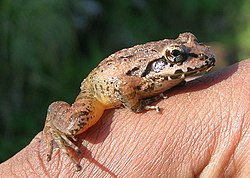Indirana
| Indirana | |
|---|---|

| |
| Adult Indirana semipalmata | |
| Scientific classification | |
| : | [[Template:Taxonomy/Indirana]] Laurent, 1986 |
| Type species | |
| Polypedates beddomii Günther, 1876
| |
| Diversity | |
| 14 species (see text) | |
Indirana is a genus of frogs in the family Ranixalidae.[1][2] These frogs are endemic to the Western Ghats of India. They are sometimes known under the common name Indian frogs,[3] whereas members of their parent family are named "leaping frogs".[1][4]
Indirana represent an ancient radiation of frogs that diverged from all other frogs almost 50 million years ago. This has credited Indirana gundia as a status of one of the "Top 100 Evolutionarily Distinct and Globally Endangered Amphibians".[5]
Description[edit]
Indirana species are small and slender-bodied frogs. They are typically found in leaf litter or near streams.[4] The tadpoles have hind limbs and finless tails, and are able to leap away to escape threats.[5][6]
Taxonomy[edit]
Traditional classifications place the genus within the subfamily Ranixalinae of the family Ranidae, along with the genera Nannophrys and Nyctibatrachus.[7] The Ranixalinae have also been placed under the family Nyctibatrachidae.[8] Darrel R. Frost et al. (2006) placed them within the family Petropedetidae.[9][10]
Species[edit]
New species are still being discovered: Indirana salelkari was discovered in the Netravali Wildlife Sanctuary in the Indian state of Goa and described in late July 2015.[11] The following species are recognised in the genus Indirana:[3]
- Indirana beddomii (Günther, 1876)
- Indirana bhadrai Garg and Biju, 2016
- Indirana brachytarsus (Günther, 1876)
- Indirana chiravasi Padhye, Modak, and Dahanukar, 2014
- Indirana duboisi Dahanukar, Modak, Krutha, Nameer, Padhye, and Molur, 2016
- Indirana gundia (Dubois, 1986)
- Indirana leithii (Boulenger, 1888)
- Indirana longicrus (Rao, 1937)
- Indirana paramakri Garg and Biju, 2016
- Indirana salelkari Modak, Dahanukar, and Padhye, 2015
- Indirana sarojamma Dahanukar, Modak, Krutha, Nameer, Padhye, and Molur, 2016
- Indirana semipalmata (Boulenger, 1882)
- Indirana tysoni Dahanukar, Modak, Krutha, Nameer, Padhye, and Molur, 2016
- Indirana yadera Dahanukar, Modak, Krutha, Nameer, Padhye, and Molur, 2016
References[edit]
- ↑ 1.0 1.1 Frost, Darrel R. (2015). "Ranixalidae Dubois, 1987". Amphibian Species of the World: an Online Reference. Version 6.0. American Museum of Natural History. Retrieved 7 August 2015.
- ↑ "Ranixalidae". AmphibiaWeb: Information on amphibian biology and conservation. [web application]. Berkeley, California: AmphibiaWeb. 2015. Retrieved 7 August 2015.
- ↑ 3.0 3.1 Frost, Darrel R. (2015). "Indirana Laurent, 1986". Amphibian Species of the World: an Online Reference. Version 6.0. American Museum of Natural History. Retrieved 7 August 2015.
- ↑ 4.0 4.1 Vitt, Laurie J.; Caldwell, Janalee P. (2014). Herpetology: An Introductory Biology of Amphibians and Reptiles (4th ed.). Academic Press. p. 503.
- ↑ 5.0 5.1 "Gundia Indian Frog (Indirana gundia)". EDGE of Existence programme. Zoological Society of London. Retrieved 1 June 2014.
- ↑ Veeranagoudar, D. K.; Radder, R. S.; Shanbhag, B. A.; Saidapur, S. K. (2009). "Jumping behavior of semiterrestrial tadpoles of Indirana beddomii (Günth.): relative importance of tail and body size". Journal of Herpetology. 43 (4): 680–684. doi:10.1670/08-158.1. S2CID 86364626.
- ↑ George R. Zug; Laurie J. Vitt; Janalee P. Caldwell (2001). Herpetology: An Introductory Biology of Amphibians and Reptiles. Academic Press. p. 430. ISBN 978-0-12-782622-6.
- ↑ "Ranixalinae". ZipCodeZoo, BayScience Foundation, Inc. Archived from the original on 2 June 2014. Retrieved 6 March 2012.
- ↑ Frost, D. R.; Grant, T.; Faivovich, J. N.; Bain, R. H.; Haas, A.; Haddad, C. L. F. B.; De Sá, R. O.; Channing, A.; Wilkinson, M.; Donnellan, S. C.; Raxworthy, C. J.; Campbell, J. A.; Blotto, B. L.; Moler, P.; Drewes, R. C.; Nussbaum, R. A.; Lynch, J. D.; Green, D. M.; Wheeler, W. C. (2006). "The Amphibian Tree of Life". Bulletin of the American Museum of Natural History. 297: 1–291. doi:10.1206/0003-0090(2006)297[0001:TATOL]2.0.CO;2. hdl:2246/5781.
- ↑ Michael F. Barej; Mark-Oliver Rödel; Legrand Nono Gonwouo; Olivier S.G. Pauwels; Wolfgang Böhme; Andreas Schmitz (2010). "Review of the genus Petropedetes Reichenow, 1874 in Central Africa with the description of three new species (Amphibia: Anura: Petropedetidae)". Zootaxa (2340): 1–49.
- ↑ "Newly discovered frog species named after Goan forest officer". Business Standard. 29 July 2015. Retrieved 2 August 2015.



